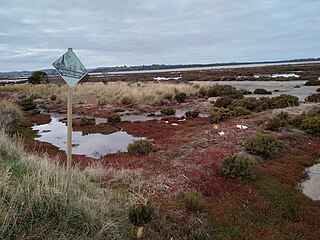Related Research Articles

Protected areas or conservation areas are locations which receive protection because of their recognized natural, ecological or cultural values. There are several kinds of protected areas, which vary by level of protection depending on the enabling laws of each country or the regulations of the international organizations involved. Generally speaking though, protected areas are understood to be those in which human presence or at least the exploitation of natural resources is limited.

The International Union for Conservation of Nature is an international organization working in the field of nature conservation and sustainable use of natural resources. It is involved in data gathering and analysis, research, field projects, advocacy, and education. IUCN's mission is to "influence, encourage and assist societies throughout the world to conserve nature and to ensure that any use of natural resources is equitable and ecologically sustainable".
This is an index of conservation topics. It is an alphabetical index of articles relating to conservation biology and conservation of the natural environment.

Man and the Biosphere Programme (MAB) is an intergovernmental scientific program, launched in 1971 by UNESCO, that aims to establish a scientific basis for the improvement of relationships between people and their environments.
A biodiversity hotspot is a biogeographic region with significant levels of biodiversity that is threatened by human habitation.

The conservation status of a group of organisms indicates whether the group still exists and how likely the group is to become extinct in the near future. Many factors are taken into account when assessing conservation status: not simply the number of individuals remaining, but the overall increase or decrease in the population over time, breeding success rates, and known threats. Various systems of conservation status exist and are in use at international, multi-country, national and local levels as well as for consumer use.
There are four categories of protected areas in India, constituted under the Wildlife Protection Act, 1972. Tiger reserves consist of areas under national parks and wildlife sanctuaries. There are 52 tiger reserves in India. As of May 2012, the protected areas of India cover 156,700 square kilometres (60,500 sq mi), roughly 4.95% of the total surface area.

Since declaring independence in 1981, Belize has enacted many environmental protection laws aimed at the preservation of the country's natural and cultural heritage, as well as its wealth of natural resources. These acts have established a number of different types of protected areas, with each category having its own set of regulations dictating public access, resource extraction, land use and ownership.

The World Database on Protected Areas (WDPA) is the largest assembly of data on the world's terrestrial and marine protected areas, containing more than 260,000 protected areas as of August 2020, with records covering 245 countries and territories throughout the world. The WDPA is a joint venture between the United Nations Environment Programme World Conservation Monitoring Centre and the International Union for Conservation of Nature World Commission on Protected Areas.

IUCN protected area categories, or IUCN protected area management categories, are categories used to classify protected areas in a system developed by the International Union for Conservation of Nature (IUCN).
The Key Biodiversity Areas (KBA) approach helps to identify and designate areas of international importance in terms of biodiversity conservation using globally standardised criteria. KBAs extend the Important Bird Area (IBA) concept to other taxonomic groups and are now being identified in many parts of the world, by a range of organisations. Examples include Important Plant Areas (IPAs), Ecologically and Biologically Significant Areas (EBSAs) in the High Seas, Alliance for Zero Extinction (AZE) sites, Prime Butterfly Areas, Important Mammal Areas and Important Sites for Freshwater Biodiversity, with prototype criteria developed for freshwater molluscs and fish and for marine systems. The determination of KBAs often brings sites onto the conservation agenda that hadn't previously been identified as needing protection due to the nature of the two non-exclusive criteria used to determine them; vulnerability; and irreplaceability.

National Parks are a legally-defined type of protected area of Brazil. The first parks were created in the 1930s, and other parks were gradually added, typically protecting a natural monument such as a waterfall or gorge near to a coastal population centre. At least two early parks were later submerged by hydroelectric reservoirs. The first park in the Amazon rainforest was inaugurated in 1974. Today the national parks cover a huge area, particularly in the Amazon. However, many of them suffer from outstanding claims for compensation from former owners or users of the land, and many lack the management plans, physical infrastructure and personnel needed to support public visits. The responsible government agency does not have the capacity to provide services such as food and drink, souvenir sales and guided tours, and bureaucracy has delayed letting the private sector bid on providing such services.
The Agulhas Front Marine Protected Area is an offshore conservation region in the exclusive economic zone of South Africa.
The Agulhas Muds Marine Protected Area is an offshore conservation Marine Protected Area region in the exclusive economic zone of South Africa.
The Namaqua Fossil Forest Marine Protected Area is an offshore conservation region in the territorial waters/exclusive economic zone of South Africa
The Browns Bank Complex Marine Protected Area is an offshore conservation region in the exclusive economic zone of South Africa

In 2010, Australia formulated a strategy for conserving land under the National Reserve System, which would be "a national network of public, Indigenous and private protected areas over land and inland water". States, territories and the commonwealth have enacted legislation to create and protect private lands "in perpetuity". Additionally, they have created mechanisms to fund the conservation of biodiversity in the shorter term. See for example, The Two Rivers Catchment Reserve.
The Sixteen Mile Beach Marine Protected Area is a coastal conservation region in the territorial waters of South Africa, near Saldanha Bay on the Western Cape coast. The MPA is part of the West Coast National Park which is the core component of the Cape West Coast Biosphere Reserve.
The Trafalgar Marine Protected Area is an inshore conservation region in the territorial waters of South Africa in kwaZulu-Natal, between Port Edward and Margate.
References
- ↑ Eleanor Carter, William M. Adams and Jon Hutton 'Private protected areas: management regimes, tenure arrangements and protected area categorization in East Africa' in Oryx Vol.42, No.2 (Cambridge: Flora and Fauna International, 2008) pp.177-186
- ↑ Mitchell, Brent (ed.) Private Protected Areas in Parks: The international journal for protected area managers, Vol. 15, No. 2 (Gland: IUCN, 2005) ISSN 0960-233X
- ↑ Langholz, Jeff and Krug, Wolf, Private Protected Area Action Plan: WPC Governance Stream, Parallel Session 2.5 (September 2003)